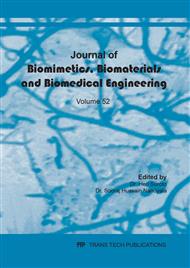[1]
Z. Heydari, M. Najimi, H. Mirzaei, A. Shpichka, M. Ruoss, Z. Farzaneh, L. Montazeri, A. Piryaei, P. Timashev, R. Gramignoli, Tissue engineering in liver regenerative medicine: insights into novel translational technologies, Cells. 9 (2020) 304.
DOI: 10.3390/cells9020304
Google Scholar
[2]
G. Mazza, W. Al‐Akkad, K. Rombouts, M. Pinzani, Liver tissue engineering: From implantable tissue to whole organ engineering, Hepatol. Commun. 2 (2018) 131–141.
DOI: 10.1002/hep4.1136
Google Scholar
[3]
P. Maghsoudlou, F. Georgiades, H. Smith, A. Milan, P. Shangaris, L. Urbani, S.P. Loukogeorgakis, B. Lombardi, G. Mazza, C. Hagen, Optimization of liver decellularization maintains extracellular matrix micro-architecture and composition predisposing to effective cell seeding, PLoS One. 11 (2016) e0155324.
DOI: 10.1371/journal.pone.0155324
Google Scholar
[4]
D. Habka, Mann D. Landes R, Soto-Gutierrez A. Future economics of liver transplantation: a 20-year cost modeling forecast and the prospect of bioengineering autologous liver grafts, PLoS One. 10 (2015) e0131764.
DOI: 10.1371/journal.pone.0131764
Google Scholar
[5]
S. Caddeo, M. Boffito, S. Sartori, Tissue engineering approaches in the design of healthy and pathological in vitro tissue models, Front. Bioeng. Biotechnol. 5 (2017) 40.
DOI: 10.3389/fbioe.2017.00040
Google Scholar
[6]
R.V. Langer, JP (1993).", Tissue Eng. Sci. 260 (n.d.) 920–926.
Google Scholar
[7]
A. Gilpin, Y. Yang, Decellularization strategies for regenerative medicine: from processing techniques to applications, Biomed Res. Int. 2017 (2017).
DOI: 10.1155/2017/9831534
Google Scholar
[8]
G. Mazza, W. Al-Akkad, A. Telese, L. Longato, L. Urbani, B. Robinson, A. Hall, K. Kong, L. Frenguelli, G. Marrone, O. Willacy, M. Shaeri, A. Burns, M. Malago, J. Gilbertson, N. Rendell, K. Moore, D. Hughes, I. Notingher, G. Jell, A. Del Rio Hernandez, P. De Coppi, K. Rombouts, M. Pinzani, Rapid production of human liver scaffolds for functional tissue engineering by high shear stress oscillation-decellularization., Sci. Rep. 7 (2017) 5534. https://doi.org/10.1038/s41598-017-05134-1.
DOI: 10.1038/s41598-017-05134-1
Google Scholar
[9]
R. Grant, D. Hay, A. Callanan, From scaffold to structure: the synthetic production of cell derived extracellular matrix for liver tissue engineering, Biomed. Phys. Eng. Express. 4 (2018) 65015.
DOI: 10.1088/2057-1976/aacbe1
Google Scholar
[10]
G. Mazza, K. Rombouts, A.R. Hall, L. Urbani, T.V. Luong, W. Al-Akkad, L. Longato, D. Brown, P. Maghsoudlou, A.P. Dhillon, Decellularized human liver as a natural 3D-scaffold for liver bioengineering and transplantation, Sci. Rep. 5 (2015) 1–15.
DOI: 10.1038/srep13079
Google Scholar
[11]
P.M. Crapo, T.W. Gilbert, S.F. Badylak, An overview of tissue and whole organ decellularization processes, Biomaterials. 32 (2011) 3233–3243.
DOI: 10.1016/j.biomaterials.2011.01.057
Google Scholar
[12]
R.D. Antarianto, A.A.A.A.P. Dewi, A. Pragiwaksana, J.A. Pawitan, Decellularization of liver cubes using multiple site syringe injection for generating native liver scaffold: Preliminary report, in: AIP Conf. Proc., AIP Publishing LLC, 2019: p.40005.
DOI: 10.1063/1.5139367
Google Scholar
[13]
F. Mußbach, U. Settmacher, O. Dirsch, C. Xie, U. Dahmen, Bioengineered livers: a new tool for drug testing and a promising solution to meet the growing demand for donor organs, Eur. Surg. Res. 57 (2016) 224–239.
DOI: 10.1159/000446211
Google Scholar
[14]
E. Moc, J. Thai, Scanning Electron Microscopy and Histology Imaging and Analysis of Decellularized Porcine Vessel, (2012).
Google Scholar
[15]
M. Lorvellec, F. Scottoni, C. Crowley, R. Fiadeiro, P. Maghsoudlou, A.F. Pellegata, F. Mazzacuva, A. Gjinovci, A.-M. Lyne, J. Zulini, Mouse decellularised liver scaffold improves human embryonic and induced pluripotent stem cells differentiation into hepatocyte-like cells, PLoS One. 12 (2017) e0189586.
DOI: 10.1371/journal.pone.0189586
Google Scholar
[16]
M.M. Bobrova, L.A. Safonova, O.I. Agapova, M.E. Krasheninnikov, M.Y. Shagidulin, I.I. Agapov, Liver Tissue Decellularization as a Promising Porous Scaffold Processing Technology for Tissue Engineering and Regenerative Medicine., Med. Technol. Med. Tehnol. v Med. 7 (2015).
DOI: 10.17691/stm2015.7.4.01
Google Scholar
[17]
E.S. Mirdamadi, D. Kalhori, N. Zakeri, N. Azarpira, M. Solati-Hashjin, Liver tissue engineering as an emerging alternative for liver disease treatment, Tissue Eng. Part B Rev. 26 (2020) 145–163.
DOI: 10.1089/ten.teb.2019.0233
Google Scholar


